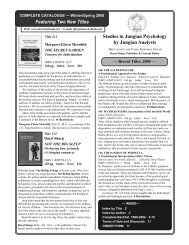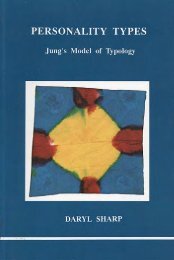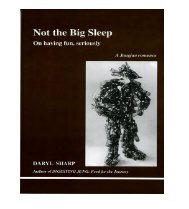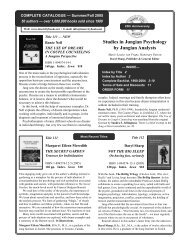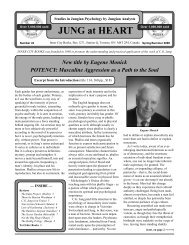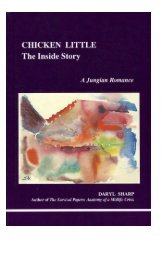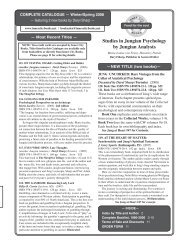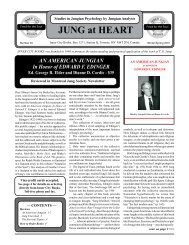Digesting Jung: Food for the Journey - Inner City Books
Digesting Jung: Food for the Journey - Inner City Books
Digesting Jung: Food for the Journey - Inner City Books
Create successful ePaper yourself
Turn your PDF publications into a flip-book with our unique Google optimized e-Paper software.
26 Shadow Boxing<br />
counseled to go into <strong>the</strong>ir fear or depression ra<strong>the</strong>r than try to escape<br />
it. “Going into” a mood means confronting it. Don’t identify<br />
with it; ra<strong>the</strong>r, give it a name and dialogue with it. The buried<br />
treasure in our moods can only be unear<strong>the</strong>d by conscious ef<strong>for</strong>t.<br />
Personally, in dialoguing with any particular shadow inclination<br />
of my own, I find it helpful, in deciding whe<strong>the</strong>r or not to act it out,<br />
to have at least <strong>the</strong>se questions in mind :<br />
1) Is it legal?<br />
2) Could it endanger my life?<br />
3) How might it affect my loved ones?<br />
4) Could I live with <strong>the</strong> consequences?<br />
A psychological crisis activates both sides of <strong>the</strong> shadow: those<br />
qualities and activities we are not proud of, and possibilities we<br />
never knew or have <strong>for</strong>gotten were <strong>the</strong>re. Associated with <strong>the</strong> <strong>for</strong>mer—according<br />
to consciously-held moral values—is a sense of<br />
shame and distaste. The latter may have morally neutral connotations,<br />
but <strong>the</strong>y are often more frightening because if we follow up<br />
on our latent possibilities <strong>the</strong>re is no telling what might happen.<br />
In practice, ego and shadow can ei<strong>the</strong>r collaborate or tear each<br />
o<strong>the</strong>r apart. This is a powerful and widespread archetypal motif. It<br />
is found in <strong>the</strong> Biblical stories of Cain and Abel, Isaac and Ishmael,<br />
Jacob and Esau; in Egyptian mythology <strong>the</strong>re is Horus and Set; in<br />
Christianity, Yahweh and Satan, Christ and Judas. In Freudian terminology<br />
it is known as sibling rivalry. In <strong>Jung</strong>ian psychology it is<br />
called <strong>the</strong> hostile bro<strong>the</strong>rs motif.<br />
One of <strong>the</strong> world’s oldest surviving myths, <strong>the</strong> Gilgamesh Epic,<br />
exemplifies this motif. It illustrates not only <strong>the</strong> initial conflict between<br />
an inflated ego and an instinctual shadow—a conflict we<br />
must all come to grips with in order to have a balanced personality—but<br />
also <strong>the</strong>ir cooperative triumphs and what can happen when<br />
one loses <strong>the</strong> o<strong>the</strong>r. The story of Gilgamesh was laboriously chiseled<br />
in stone tablets some seven thousand years ago. Briefly, it goes<br />
like this:<br />
Gilgamesh was a young Sumerian ruler, half man and half god,



